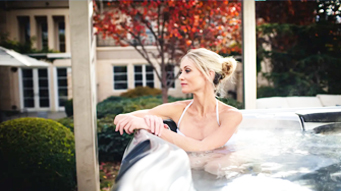What’s the difference between chlorine and bromine?
First of all, why do we actually need chorine or bromine in our spa water? Good question!
Well, like it or not, hot tubs provide the ideal conditions for bacteria to grow.
There is a source of food (from the bathers), a lovely warm temperature (30-40c) and of course, moisture. Lots of it!
Bacteria and pathogens that can grow in the water include legionella, pseudomonas aeruginosa, mycobacterium and cryptosporidium. What can we do to prevent this?
We can use chlorine and bromine to prevent this growth.
Chlorine
Chlorine is the most popular sanitiser on the market. It is an affordable and effective method of sanitising a spa.
The ideal chorine level should be around 3-5mg/l (three to five milligrams per litre)
How does chlorine work I hear you ask? When chorine is dissolved, it creates hypochlorous acid. It is this that breaks down the bacteria in the water to create a safe and sanitised environment for bathing. Once the hypochlorous acid has broken the bacteria down, it becomes deactivated. This is called combined chlorine.
Combined Chlorine
The hypochlorous acid kills bacteria and it also reacts with sweat, urea and bather contamination (ammonia). Combined chlorine can cause skin and eye irritation and is responsible for the characteristic chlorine smell in pools and spas.
How do we deal with this? How can we reduce or remove combined chlorine from the water?
Reduce: UV, ozone, regular shock dosing, users taking a pre-bathing shower to remove contaminants.
Remove: Shock dose using an oxidiser.
Bromine
Bromine is an affordable and effective method of sanitising a spa or hot tub. Many people find that bromine has less odour and is kinder to the skin than chlorine.
The ideal bromine level for a domestic setting is 3-5mg/l and in a business setting around 4-6mg/l.
Again, the voice from the back asks ‘how does bromine work?’
When bromine is dissolved in spa water, it creates hypobromous acid. It is this acid that breaks down bacteria creating a safe and sanitised environment for bathing. After breaking down the bacteria, it becomes combined bromine and it still retains a small amount of sanitising effectiveness. The by-product is Bromamines, not as problematic and Chloromines but regular shocking is required to tackle it. This cannot be reactivated but the Bromine Ions in the water can be (which is what we add when dosing the product).
Combined bromine
When the hypobromous acid reacts with any organic content it is reduced back to bromide ions. Most, but not all, of these ions can then be reactivated back to hypobromus acid by adding an oxidiser. More bromide salt or ions need to be added periodically to make up the lost ions.
Brief summary
Chlorine v. Bromine
Properties Chlorine Bromine
Disinfection Effective at killing bacteria Effective at Killing bacteria
Cost ££ ££££
Shock dosing Needs regular shock dose to Needs regular shock dose to
remove combined chlorine. regenerate bromide ions
Benefits Cheap, accessible, easy to use Kind on skin and hair
It is worth noting that a bromine sanitised spa cannot be switched over to chlorine easily if there is still bromine in the water. All of the chlorine will be going to converting bromide ions into hypobromous acid. As long as there are 15 ppm or more of bromide ions in the water, none of it will provide a chlorine residual. The spa will continue to be bromine sanitised until the bromide level falls below 15 ppm. Unfortunately, there isn’t a test kit for measuring just bromide ions in the water and so it may take many many weeks. Draining and refilling may be the reliable option here.
